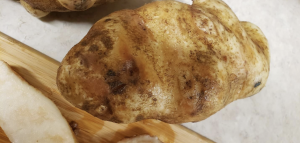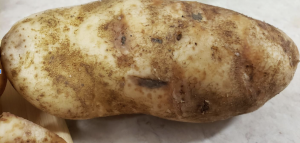-Andrew Plant, MPB pathologist
Pink eye of potato is a physiological disorder of tubers that often results in pinkish colored skin tissue, usually from the middle to bud end of tubers, and often most evident around the eyes, hence the name.
Early studies on the disorder often attributed it to one or more pathogens such as Rhizoctonia, Verticillium, or Pseudomonas, but researchers could never duplicate the symptom occurrence with any of the pathogens that they tested. A connection was finally made with its appearance and severity usually on “stressful” growing seasons.
A typical pink eye year is one where there is above normal heat, dry conditions, then often followed by above normal moisture that saturates or oversaturates soil. Further research into pink eye, has led to a movement to rename it to “periderm disorder syndrome.” Briefly, high soil temperatures and water saturated soils damage tuber periderm cells (skin) and the cells below it, causing malfunction and malformation of new periderm or suberin layers (wound healing layers).
This past growing season, much of the area saw 3-4” below normal rainfall in July and August, with 5-6F above normal temperatures in July (with 3 days 90F or over). September and October have now provided us too much moisture as we are 1.5-2” above normal for the time period in many locations.
Overview of Pink Eye:
 – Often seen at harvest or just prior to.
– Often seen at harvest or just prior to.
– Often seen starting 7-10 days after a significant rain event late in the season. Usually an environmentally stressful growing season.
– At harvest, can be observed as typical pink eye symptoms (as described above), or if more progressed, can be water soaked (with no pink coloration), or even further developed into elephant hide.
– If pink eye symptoms appear at harvest, they are typically short-lived (several weeks), with the color disappearing, and often progress to an elephant hide.
– Can often be confused for tuber late blight infections, or sometimes with pink rot as sliced tubers may show some pink discoloration in the tuber flesh.
– Affected tubers are more susceptible to shrinkage in storage as well as infections by fungi or bacteria.
Management:
Pink eye is difficult to manage as we can’t necessarily manage all of the environmental factors that attribute to its occurrence, but outlined below are several things you may consider to help alleviate or minimize some of those factors.
– Minimize stress: Consider irrigation, although water-logged soils, especially late in the season, can contribute to pink eye, careful irrigation throughout the season will decrease drought stress and help buffer soils from high summer temperatures.
– Deep tillage: Research in Wisconsin showed increased pink eye incidence with increasing soil compaction levels. Deep tillage in this research showed better water drainage and cooler soil temperatures, and led to decreased amounts of pink eye compared to untreated soils.
– Keep your crop canopy healthy and full: Not only does it maximize photosynthetic capacity, it also acts to shade the soil that the tubers are growing in, helping keep soil temperatures down.
– Fields that succumb to Potato Early Dying (PED), or other maladies that cause foliage loss or early senescence are often associated with pink eye development.
– Post-harvest: With pink eye afflicted tubers being more susceptible to rot, consider treatments to help control fusarium, pink rot, and leak. Having a sufficient curing period, and providing time for the pile to dry and be well ventilated will provide benefit in keeping rot levels down.
